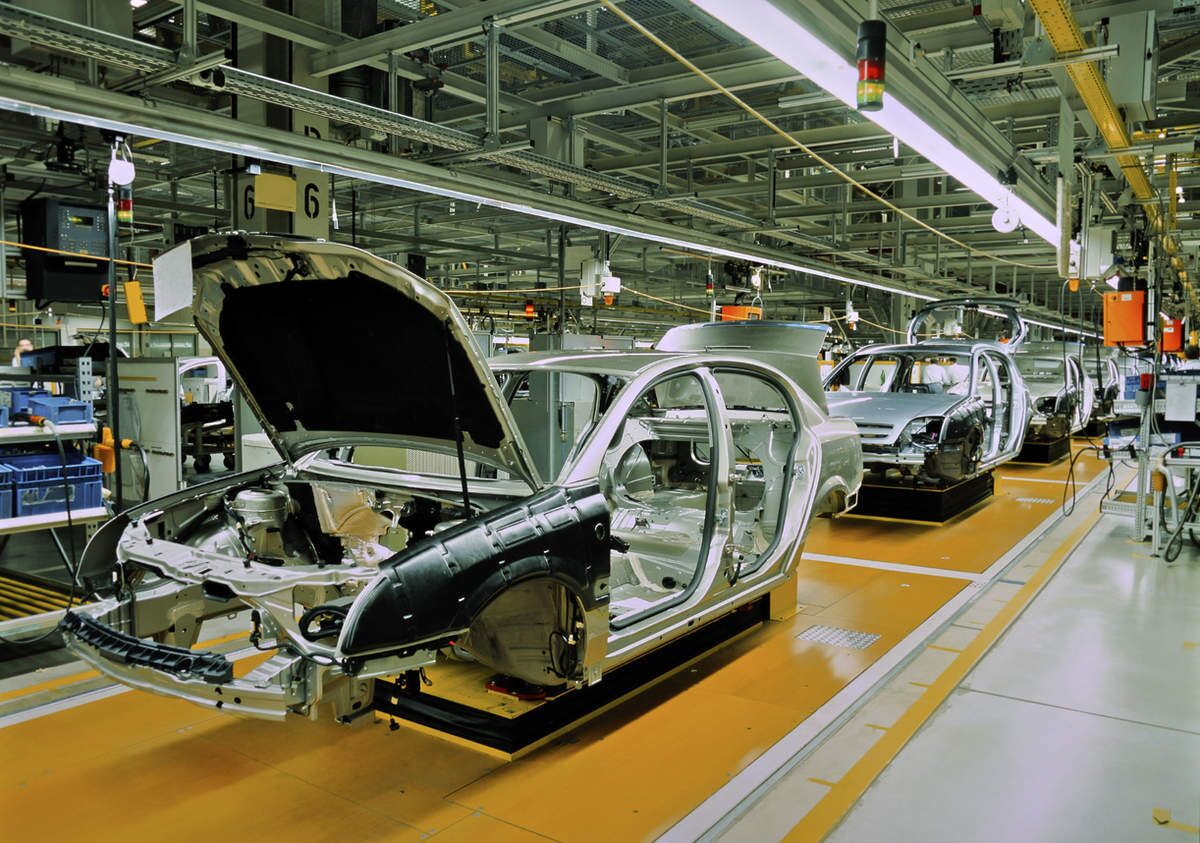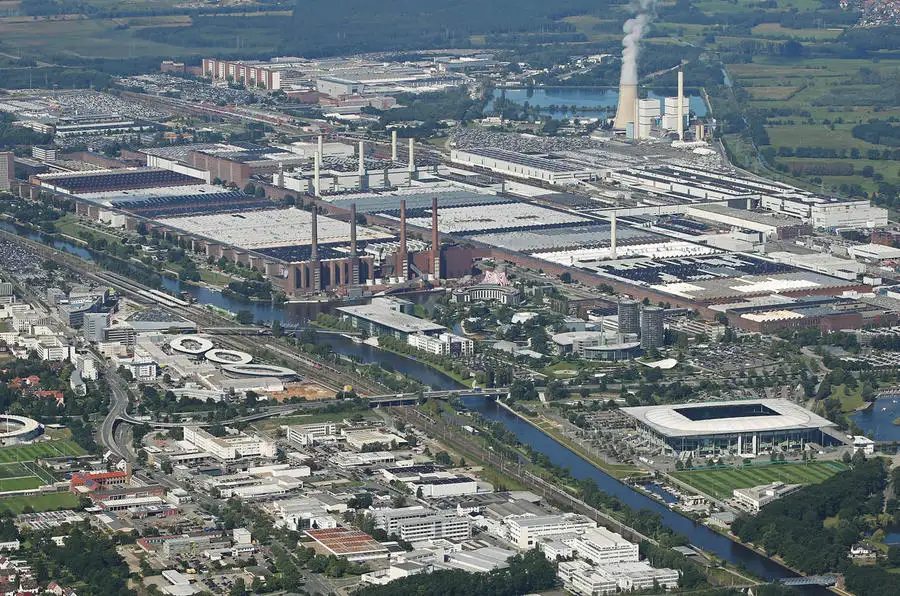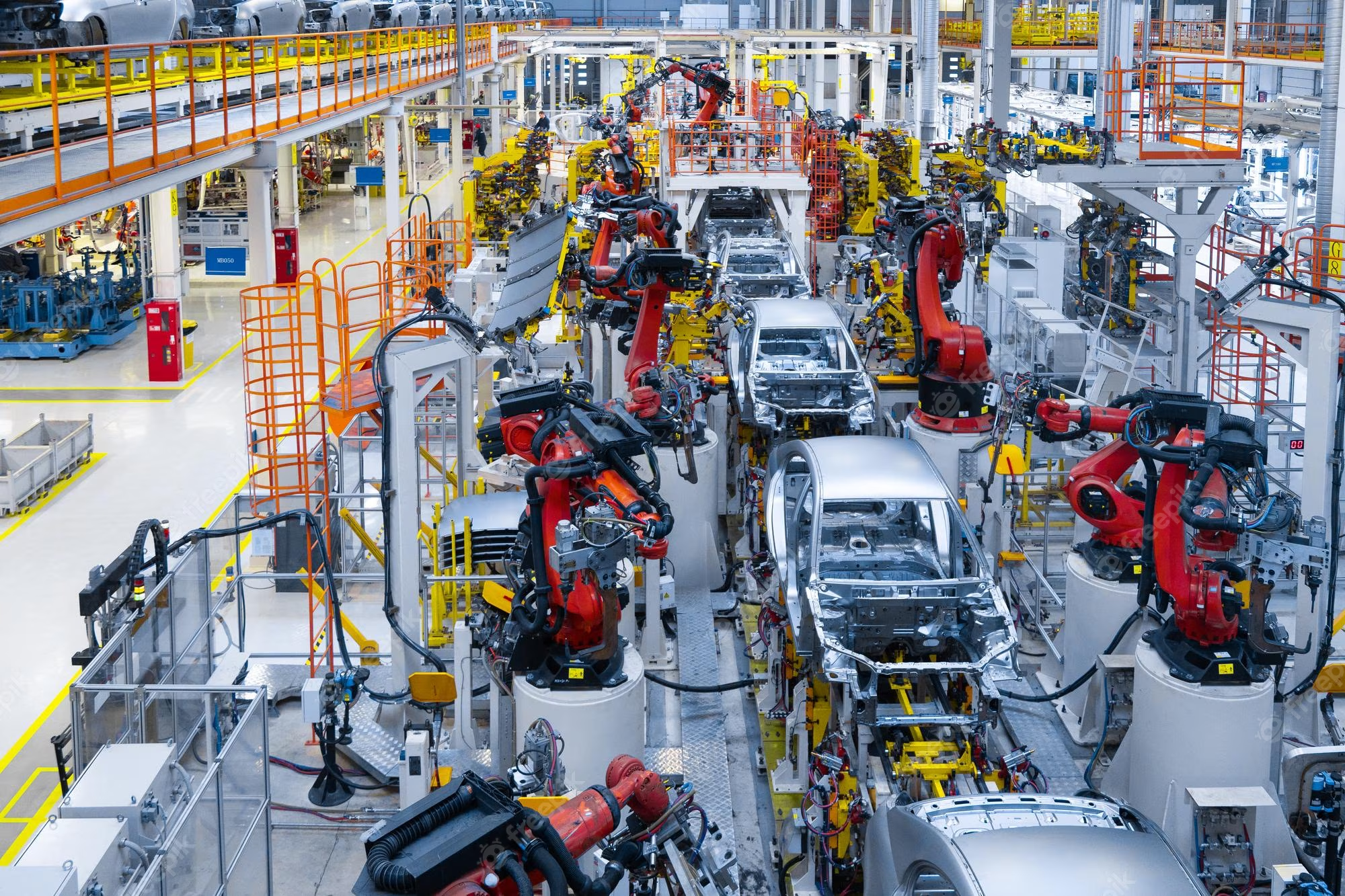Car factoriesare marvels of engineering and precision, where raw materials are transformed into fully functional automobiles. The process involves an intricate dance of machines, human expertise, and efficient systems. In this article, we will take a detailed look at the various stages and components involved in the functioning of a car factory.
What Is The Manufacturing Process For Cars?
Automobile, truck, and other motor vehicle assembly is known as the automotive manufacturing process.
This lengthy and complex process begins with designing the vehicle and all of its pieces, continues with assembling the parts, includes testing the vehicle, and ends with delivering the finished product to the customer.
The production of automobiles necessitates the use of specialized machinery, highly skilled labor, and a range of raw materials.
What Does The Manufacturing Process Workflow For The Automotive Industry Look Like?
The production of automobilesis an intricate process that includes numerous processes. As a manufacturer, you are required to adhere to stringent policies and procedures to guarantee that your vehicles are of the highest caliber.
Automobile manufacturers also begin the quick prototyping of their products. This is because they will be able to evaluate how well the prototypes work in various settings by testing them.
The preparation of tools and equipment comes after the design, development, and product analysis stages of the automotive production process are finished. The tools and equipment required for the mass production of your automobiles must be created and sourced in this situation by the manufacturer.
Everything from paint booths to stamping equipment is included. Production planning comes after the preparation of the tools and equipment. You will choose how many automobiles to create and when in this phase.
A master production schedule can actually help you navigate the timing of the various stages of your vehicle manufacturing process. A set of quality control tests is the final process the car goes through after the assembly activities.
By doing this, you can make sure that your customers are happy and that you are abiding by the law. Customer retention will increase as a result, and your net revenue and net profit ratio will also improve.
Car Factories
Although they appear to have begun at the turn of the 19th century, production lines have actually existed for much longer. A manufacturing line essentially employs a division of labor. In a system of division of labor, each person takes on a tiny portion of the work and brings the smaller pieces together until the task is completed, rather than completing the entire task by themselves from beginning to end.
Of course, chores around the house or farm have always been distributed among people. However, for the majority of human history, if something needed to be constructed or made, it was done entirely by one person. Expert craftspeople mastered the art of producing one specific item. They would take a product from beginning to end and train others to do the same. The craftsman might then exchange the finished item for any items that he or she needed after finishing the project.
The main issue with this system is how time-consuming it is. A talented craftsperson may need to complete several years of training as well. Additionally, it increased the price of the products that artisans produced.
Craftspeople discovered that the work went a little faster after they started breaking down the individual activities required in creating a particular product. At first, people continued to perform unskilled work in their houses. For instance, a milliner would have someone at home cut hat patterns while someone else put together imitation flowers, made bows out of ribbons, and stitched the fabric together before someone else put the entire hat together.
Even still, some talent was needed for those assignments, and the workflow was a little slow. But as soon as the process became more automated, people saw how much faster it might go. Additionally, less trained laborers may be used if there is more machinery used in the production process. For instance, a milliner now just needed to recruit a worker who could put fabric into a cutting machine rather than one who could cut that fabric to match a pattern.
The only sewing skill required of the workforce was to feed fabric through a sewing machine. Because the labor was unskilled, the procedure was quicker and cheaper as well. The decision to incorporate machines into the manufacturing process enabled the mass production of a wide range of goods, including automobiles.
Early Automobile Assembly Lines
Coach builders played a major role in creating the first automobiles. In the beginning, automakers would purchase engines from a producer and put them in a modified horse carriage. In fact, this is the reason why businesses that still hand-build vehicles today are frequently referred to as coaches. To manufacture their coaches specifically customized to each order, the builders typically used experienced craftspeople. Customers had complete design control over the interior and exterior of their new car.
However, coach builders soon realized that by standardizing the design and components, they could produce more cars more quickly. All of the car's parts may be manufactured utilizing molds and machinery, as opposed to each one having to be individually fabricated. The last component would then be put together by the workers.
Contrary to popular belief, Ransom Eli Olds actually invented the car assembly line, not Henry Ford. Olds had spent the majority of his life working on automobiles, including steam-powered vehicles in the 1880s and 1890s. He was the first mass producer of automobiles in the United States thanks to his assembly line, and he ruled the country's automotive sector from 1901 to 1904.
However, Ford took the concept and made it better, which is why most people believe he invented the car assembly line. The de-assembly line in a slaughterhouse served as inspiration for Ford's assembly line. Despite the fact that Henry Ford's assembly line was much more effective, Henry Olds' vehicle assembly line may have been the first. Workers were assigned to a single production task on the Ford assembly line. There was a production station for each task. The worker would repeatedly complete the assigned duty on each passing automobile as it arrived at the station in the shape of a car. The factory was producing hundreds of automobiles at once since each worker only had one task and only worked on one car at a time. A Ford Model T could be put together from start to finish in 93 minutes at the original Ford factory. In actuality, a finished car rolled off the assembly line every three minutes.
Modern Car Factories Process
In the design phase, factors such as aerodynamics, fuel efficiency, safety standards, and ergonomics are carefully considered. Engineersuse advanced modeling techniques to evaluate different design iterations, ensuring the final product meets both regulatory requirements and customer expectations. Collaborative efforts and constant refinements result in a well-thought-out blueprint for the car's production.
Sourcing Of Raw Materials
Car factories require a vast array of raw materials, including steel, aluminum, rubber, plastics, and electronics. These materials are sourced from various suppliers across the globe. The factory's logistics team ensures a steady supply of materials, maintaining inventory levels to avoid production delays.
Sourcing materials involves negotiating contracts, ensuring the quality of supplies, and managing transportation efficiently. Sustainable practices are increasingly becoming a priority in the automotive industry, with manufacturers seeking eco-friendly alternatives and recyclable materials to reduce their environmental impact.
Stamping And Pressing
The process of car manufacturing begins with the stamping and pressing of metal sheets. Huge presses exert enormous force to shape these metal sheets into various car body parts like doors, hoods, fenders, and roofs. Precision is critical at this stage, as any inaccuracies can lead to flaws in the final product.
The stamping process utilizes complex dies and molds, which are meticulously designed to achieve the desired shape and dimensions. Advanced sensors and computer-controlled systems monitor the process, ensuring consistency and minimizing waste. This stage marks the birth of the car's body components, setting the foundation for the rest of the assembly process.
Welding And Body Assembly
Once the individual car parts are stamped, they move to the welding and body assembly sections. Highly skilled technicians use robotic welding machinesand manual welding techniques to join the various parts, creating the car's skeleton. This stage requires precision and consistency to ensure the vehicle's structural integrity and safety.
Robotic welders work with speed and accuracy, following programmed patterns to fuse metal pieces together. Human welders handle more intricate and delicate tasks, ensuring critical joints and seams are perfectly aligned. The welding process also involves the application of sealants and adhesives, further reinforcing the car's body structure.
Painting
The car body is now ready for painting. It goes through an extensive process of surface preparation, cleaning, and priming before being immersed in a series of paint booths. Robots and skilled painters apply layers of primer, base coat, and clear coat to achieve the desired finish. The painting process not only enhances the car's appearance but also provides protection against corrosion.
Modern car factories employ advanced technologies like electrostatic painting to ensure an even and efficient application of paint. Additionally, sophisticated drying systems, such as infrared ovens, speed up the curing process. Throughout the painting stage, strict quality control measures are in place to detect any imperfections and maintain consistent color matching.
Engine And Mechanical Assembly
While the car body receives its paint job, the engine and other mechanical components are simultaneously assembled. Engines, transmissions, suspensions, and other crucial parts are installed with precision and tested for functionality.
Automated assembly lines play a vital role in this stage, as they optimize efficiency and reduce the likelihood of errors. As the car moves along the assembly line, various specialized teams install specific components. Highly trained technicians work alongside robotic arms to connect intricate systems such as the engine and transmission. After each assembly step, functional tests are conducted to ensure all components work harmoniously.
Electrical Systems Installation
With the car's mechanical components in place, it's time to install the electrical systems. Skilled technicians lay down miles of wiring, connecting various electronic components such as sensors, lights, entertainment systems, and safety features. This stage requires careful attention to detail to avoid electrical malfunctions in the final product.
As vehicles become increasingly technology-driven, electrical system installation is becoming more complex. Car manufacturers implement stringent protocols to prevent wiring errors, short circuits, and potential hazards. Computerized testing systems analyze the car's electrical functions, allowing technicians to identify and rectify any issues efficiently.
Interior Installation
The car's interior, including the seats, dashboard, carpets, and trimmings, is installed at this stage. Automation and skilled labor work hand in hand to achieve a high-quality interior finish that matches the car's brand and model specifications.
Robotics often assist in installing larger interior components, while meticulous craftsmanship is required for intricate details. Fit and finish are critical aspects, as consumers expect a comfortable and aesthetically pleasing cabin. Advanced inspection techniques, such as laser scanning, help ensure that the interior components align precisely.
Quality Control
Quality control is a critical aspect of car manufacturing. Throughout the production process, random samples are pulled from the assembly line and subjected to rigorous tests to ensure they meet safety and performance standards. Defective parts are rejected or reworked to maintain the highest level of quality.
Car factories implement a combination of manual inspections and automated systems to scrutinize every aspect of the vehicle. From dimensional accuracy to functional tests, each car undergoes an exhaustive evaluation before proceeding to the next stage. Quality control is not limited to the assembly process; it also extends to components received from suppliers.
Final Testing
Once the car is fully assembled, it undergoes comprehensive testing to validate its performance, safety features, and adherence to the company's specifications. Test drivers evaluate the vehicle's handling, acceleration, braking, and other key attributes on test tracks and under different conditions.
In addition to dynamic testing, final inspections are conducted to ensure that all parts and systems meet the factory's standards. Cars are subjected to various environmental tests, including extreme temperatures and road simulations, to identify potential weaknesses. Only after successfully passing all tests does the car receive its stamp of approval for sale.
Packaging And Shipping
After passing all the tests, the cars are meticulously cleaned, polished, and prepared for shipping. Depending on the destination, the vehicles are either loaded onto transport trucks or shipped overseas in containers. This stage demands efficient logistics to ensure timely delivery to dealerships around the world.
Car manufacturers work closely with logistics partners to optimize shipping routes and minimize transportation times. Tracking systems provide real-time updates on the cars' locations, enabling dealerships and customers to anticipate delivery dates accurately. Additionally, eco-conscious manufacturers explore ways to reduce their carbon footprint during the shipping process.
Innovations In Car Manufacturing
The automotive industry is constantly evolving, and car factories are at the forefront of adopting innovative technologies and processes. From electric vehicles to advanced driver assistance systems (ADAS), manufacturers are pushing the boundaries of what cars can offer.
In recent years, electric vehicles (EVs) have gained significant traction due to their environmental benefits and increasing consumer demand for sustainable transportation options. Car factories are retooling their assembly lines to accommodate the production of electric cars, which require different components and manufacturing techniques compared to traditional internal combustion engine vehicles. Learn more about the shift in innovation in new marketshere.
Advanced driver assistance systems (ADAS) are another notable innovation. These systems use sensors, cameras, and artificial intelligence to enhance vehicle safety and convenience. Car factories are integrating ADAS technologies into their vehicles, allowing for features like adaptive cruise control, lane-keeping assistance, and automatic emergency braking.
Challenges And Solutions
Car manufacturing is not without its challenges. One significant issue is the global shortage of semiconductor chips, which are essential for modern vehicles' electronic components. Car factories have had to adjust their production schedules and prioritize certain models due to the limited availability of these chips.
To address such challenges, car manufacturers are investing in research and development, seeking alternative suppliers, and exploring ways to optimize chip usage. Moreover, industry collaborations and government initiatives are being pursued to improve the semiconductor supply chain resilience.
Visit Gadgets Gaadi for the latest tech and automotive news
The Future Of Car Factories
As car factories continue to innovate, the future of automotive manufacturing looks promising. Industry experts predict increased automation, with robots and artificial intelligence playing more significant roles in assembly processes. This automation can lead to higher production efficiency and improved product consistency.
Furthermore, car factories are likely to become more environmentally conscious, adopting sustainable practices such as energy-efficient manufacturing processes and eco-friendly materials. The adoption of renewable energy sources within the factories themselves can contribute to reducing the industry's carbon footprint.
People Also Ask
Where Are The Most Car Factories?
China has become the world's largest automotive market, and many major global automakers have established manufacturing facilities within the country to cater to the increasing demand for vehicles in the domestic market and for export purposes. Additionally, China's relatively lower production costs and favorable government policies have attracted significant investments from automotive companies worldwide.
What Is The Largest Car Factory In The World?
The Gigafactory Shanghai is Tesla's first manufacturing plant outside the United States and has a sprawling campus dedicated to producing electric vehicles. It plays a crucial role in Tesla's efforts to meet the high demand for its electric cars in China and other Asian markets. It's worth noting that the status of the largest car factory may change over time as automakers continue to expand their operations and build larger facilities in response to market demands.
What Car Factories Are In The UK?
- MINI Plant Oxford: Located in Oxford, this plant is operated by BMW Group and is responsible for producing various models of the MINI brand, including the iconic MINI Cooper.
- Jaguar Land Rover Castle Bromwich: Situated in Birmingham, this facility is owned by Jaguar Land Rover and produces luxury vehicles under both the Jaguar and Land Rover brands.
- Nissan Sunderland Plant: Located in Sunderland, this plant is operated by Nissan and is one of the largest automotive manufacturing facilities in the UK. It produces a range of Nissan models, including the popular Nissan Qashqai.
- Toyota Burnaston Plant: Situated in Derbyshire, this plant is operated by Toyota and manufactures Toyota vehicles, contributing to the Japanese automaker's presence in the European market.
Conclusion
Car factories are complex and sophisticated facilities that bring our beloved automobiles to life. From the initial design and planning stages to the final quality checks and shipping, every step involves a blend of cutting-edge technology, skilled labor, and meticulous attention to detail. The result is the vehicles we drive every day, reflecting the culmination of human ingenuity and engineering prowess. As technology continues to evolve, car factories will embrace automation and sustainable practices, shaping the future of automotive manufacturing.


